巴西航空工业公司推出全新飞鸿 100EX 打造轻型公务机市场
单驾驶员 Phenom 100EX 的 4 名乘客航程为 1,178 海里(符合 NBAA IFR 储备)。 (照片由巴西航空工业公司提供。)
单驾驶员 Phenom 100EX 的 4 名乘客航程为 1,178 海里(符合 NBAA IFR 储备)。 (照片由巴西航空工业公司提供。)

The SR Series G7 introduces new Push Button Start functionality and refinements such as high-performance Beringer brakes and low-drag advanced wheel fairings. (Photo courtesy of Cirrus Aircraft.)
Cirrus Aircraft has unveiled the latest generation of its SR Series family of piston single aircraft with the heavily upgraded SR Series G7. Pilots and passengers are in store for improved avionics, a redesigned and roomier cabin, enhanced amenities, advanced safety systems, better performance, and more. The SR Series lineup includes the SR20, SR22, and SR22T (turbocharged) models.
Cirrus says it redesigned every corner of its SR Series G7 airplanes’ cabins. The result is more legroom for all occupants, redesigned interior panels with dimmable task lights and ambient accent lighting, illuminated cupholders, powered headset jacks, lighted USB-C ports within each passenger’s reach, and other improvements.
The aircraft also boasts features such as a new automotive-style environmental control system and 60/40 Flex Seating that provides excellent loading flexibility. Customers can order the plane in a limited Launch Edition design scheme that commemorates the SR Series G7’s launch or in one of five other premium interior and exterior design options.
Pilots will have what Cirrus says is the industry’s most advanced flight deck at their fingertips with Garmin’s Cirrus Perspective Touch+. The avionics suite has larger, high-resolution 12-inch widescreen displays (14-in. displays are optional) with three times more resolution. Cirrus says the SR Series G7 is also the first piston aircraft to incorporate Garmin Touch Controllers.
The manufacturer says these larger displays combined with expanded systems integration mean a reduced workload and increased situational awareness for pilots. Pilots can easily navigate CAS-linked checklists using the Checklist Scroll Wheel, while integration of Taxiway Routing and 3D SafeTaxi will make airport ground navigation easier.

Cirrus customers will enjoy a long list of upgrades with the new SR Series G7, including larger, more colorful displays perfect for viewing charts, tracking weather, and managing flight plans. (Photo courtesy of Cirrus Aircraft.)
All Cirrus aircraft already include the Cirrus Airframe Parachute System (CAPS). The SR Series G7 introduces additional advanced safety components such as Stick Shaker, which enhances low-speed situation awareness, and Flap Airspeed Protection, which monitors airspeed to prevent accidentally deploying or retracting the flaps.
Performance specs vary among SR Series models. For example, the SR22T’s turbocharged 6-cylinder Continental TSIO-550-K engine is rated for 315 horsepower (235 kilowatts) compared to the SR20 power plant’s 215 HP (160 kW). The SR22T’s engine enables an increased maximum operating altitude of 25,000 feet (7,620 metres) vs. 17,500 ft (5,334 m) for the SR20 and SR22.
The SR22T has an average flight range of 763 nautical miles (1,413 kilometres) and a maximum range of 1,021 nm (1,890 km) at 55% power. That compares to the SR20’s maximum 709-nm (1,313-km) range and the SR22’s 1,169-nm (2,165-km) range. Maximum cruise speeds vary from 155 ktas for the SR20 to 213 ktas for the SR22T.
Explore AviationTrader.com.au to shop and compare hundreds of new and used Cirrus Aircraft aeroplanes for sale, such as SR Series models like the SR20 and SR22.
To determine how much specific aircraft will cost your organisation over time, and to compare the operating costs of multiple types of aircraft, visit Aircraft Cost Calculator.

This post is courtesy of TracPlus.
TracPlus, a global leader in real-time tracking and communication solutions, addresses the impending global 3G network shutdown, guiding all users of 3G aircraft tracking systems, including its RockAIR devices and those from other providers. The transition away from 3G networks, happening now and continuing over the next few years, varies by region. TracPlus provides essential guidance on how to navigate this change, outlining steps for users to ensure continuous, reliable operational connectivity during and after the transition. This initiative highlights TracPlus's commitment to innovation, safety, and reliability in the face of significant telecommunications evolution.
As global telecommunications shift towards 4G and 5G networks, the phasing out of 3G services presents widespread challenges for users of 3G-dependent aircraft tracking systems. This transition is occurring at different paces globally, affecting regions in unique ways. For example, in the United States, major network providers have already begun decommissioning their 3G networks, with the process expected to be largely completed by the end of 2023. In contrast, countries like Australia and New Zealand have set a timeline extending through 2024 and 2025, respectively. In Europe, the scenario varies by country, with some like the UK planning to phase out 3G by 2023, while others may extend beyond that. These regional differences in the shutdown timelines are critical for users to understand, as they directly impact the operational connectivity and the need for timely upgrades or adaptations to maintain continuous, reliable service.
The gradual shutdown of 3G networks will affect all 3G GSM and satellite network-based aircraft tracking devices. Users of these systems will experience a shift towards greater reliance on satellite communications. This transition, while affecting connectivity, does not mean the end of utility for these devices. It's important to note that as 3G towers are decommissioned, devices with multi-carrier capabilities, such as TracPlus's RockAIR, may offer more resilience. However, post-shutdown, all 3G tracking devices will need to operate in a satellite-only mode, which may result in higher operational costs due to increased satellite data usage.
In anticipation of these industry-wide changes, TracPlus introduced the LTE-compatible RockAIR model in late 2022. This move highlights the importance of staying abreast of technological advancements. For users of other 3G tracking systems, exploring options for 4G-compatible upgrades with their respective providers is recommended to ensure continued high-quality connectivity and performance.
TracPlus is committed to leading the way through the challenges of the 3G network shutdown, offering guidance not only to its customers but to all users of 3G aircraft tracking systems. With a focus on providing comprehensive solutions and proactive support, TracPlus aims to ease the transition for the entire aviation community. All users impacted by the 3G shutdown are encouraged to seek guidance and support from their device providers and consider available options for adapting to these technological changes.
After delivering 65 Ipanema agricultural airplanes in 2023, Embraer expects to deliver 70 units of the ethanol-powered plane in 2024. (Photo courtesy of Embraer.)
Brazilian aircraft manufacturer Embraer recently delivered the 1,600th unit of its Ipanema agricultural airplane model, used for crop-dusting soybeans, corn, coffee, and other crops. Embraer has produced the Ipanema uninterrupted for five decades. In 2023, it delivered 65 units—an 18% increase vs. 2022—and says it expects to deliver 70 Ipanema airplanes this year.
Embraer, which also produces Phenom 100EX and 300E and Praetor 500 and 600 business jets and aircraft for the commercial aviation and defense and security sectors, began producing the Ipanema in the 1970s. It introduced the Ipanema EMB-203 model in 2015 with redesigned winglets and a 235-kilowatt (320-horsepower) Lycoming engine. Embraer unveiled the current incarnation of the EMB-203 in 2020.
The plane can reportedly dust up to 200 hectares (494 acres) per hour. Embraer also says it’s the only agriculture airplane certified and produced in series to operate on 100% ethanol, and further claims that the renewable energy source provides the engine with increased power.
Embraer credits demand for the Ipanema with driving expansion at its factory in Botucatu, Brazil, which employs more than 1,800 workers, and cites the plane’s positive impact on Brazil’s economy.
"Agribusiness has a significant positive impact on Brazil's gross domestic product (GDP), and we are very pleased to see how the Ipanema has contributed to the sector's high productivity, efficiency, and sustainability," says Sany Onofre, manager of the Embraer Ipanema program.

Employees at Embraer’s factory in Botucatu, Brazil, celebrate the 1,600th delivery of the company’s Ipanema agricultural airplane. (Photo courtesy of Embraer.)
AviationTrader.com.au regularly hosts listings for new and used piston agricultural aircraft and turbine agriculture aircraft for sale. Browse the site for numerous Embraer business jets for sale, as well.
To determine how much specific aircraft will cost your organization over time, and to compare the operating costs of multiple types of aircraft, visit Aircraft Cost Calculator.

This post is courtesy of Diamond Aircraft.
Diamond Aircraft together with Utility Air, Diamond Aircraft distributor for Australia and New Zealand, have announced that six new Diamond DA40 XLT Aircraft have been sold to the University of New South Wales’ School of Aviation (UNSW Aviation). The aircraft, in UNSW livery, will be hangered in Sydney and used to complement the existing eight DA40 aircraft already owned by UNSW Aviation. As part of the deal, Utility Air will also sponsor UNSW Aviation’s Electric Vehicle Racing Development team.
John Oppenheim, a Director of Utility Air, commented, “The University of New South Wales is an organization which we are proud to be associated with. Their School of Aviation are excellent customers, and the further expansion of the fleet is a testimony to the strength of the Diamond product and also our relationship.”
Utility Air’s Managing Director, Stephen Pembro was effusive about the deal. “To be able to sell a fleet of aircraft to UNSW Aviation is wonderful, and to be able to sponsor the development of Electric Propulsion at the University further enhances our green credentials, something we take very seriously at Utility Air.”
Malcolm Good, Director of Flying Operations at UNSW added, “UNSW Aviation is delighted to continue our strong relationship with Utility Air and Diamond Aircraft Industries with the purchase of six DA40 XLT aeroplanes. A fantastic addition to our existing fleet of DA40s to enable UNSW Aviation to deliver safe and effective flying training to the next generation of aviation leaders.”
The DA40 XLT boasts a durable and aerodynamically efficient all-composite airframe, industry-leading Garmin G1000 NXi, and is powered by the 180HP IO-360 Lycoming engine. The aircraft has proven itself to be a reliable training aircraft with superb safety and rugged dependability.
Four of the aircraft will be delivered in 2024 and two in 2025.
Diamond’s dedication to flight training has shaped its product line of modern fuel-efficient aircraft, each with a specific training application in mind. With its complete line of piston aircraft including a dedicated flight training concept with Single Engine Piston (DA40 NG, DA40 XLT) and Multi Engine Piston (DA42-VI) trainers, along with type-specific flight training simulators and proprietary jet-fuel engines, Diamond Aircraft is the only sole source provider in the flight training market. For more information, please click here.
You’ll find scores of Diamond aircraft for sale on AviationTrader.com.au, including a big selection of DA40 piston-single airplanes.

Textron Aviation CEO and President Ron Draper says the CJ3 Gen2 is the company’s “most comprehensive Gen2 product announcement yet, offering customers proven performance, leading-edge technology, and an unmatched cabin experience.” (Photo courtesy of Textron Aviation.)
Textron Aviation expects to release its new Cessna Citation CJ3 Gen2 light business jet in 2025. In October, the manufacturer displayed a mockup of the 10-passenger aircraft at the National Business Aviation Association—Business Aviation Convention & Exhibition (NBAA-BACE).
The company says it’s already seeing strong demand and orders. The new aircraft design features cockpit and cabin enhancements, making it Textron Aviation’s most comprehensive Gen2 product yet.
Textron has shared videos featuring members of its Customer Advisory Board that provided feedback key to enhancements implemented throughout the jet. In one video, Stephen Elop, a pilot who has held senior leadership positions at Adobe, Juniper Networks, Microsoft, and Nokia, says incorporating a datalink system is a game changer.
“What that means to me is database updates can happen quickly and automatically in the background, reducing a huge amount of work for me,” Elop says. “For example, before I head to the airport to get ready for a departure, I can tell from my computer at home whether it’s been fuelled or not.”
The twin Williams International FJ44-3A engines that power the CJ3 Gen2 can operate on sustainable aviation fuel (SAF). The jet utilises a conventional wing design with a computer-sculpted airfoil that enables uninterrupted air to flow across more of the aircraft surface for more lift with less drag.
The aircraft has a maximum flight range of 2,040 nautical miles (3,778 kilometres) and a maximum cruise speed of 416 ktas. It has a maximum payload of 968 kilograms (2,135 pounds) and a useful load of 2,508 kg (5,530 lbs).

CJ3 Gen2 pilots will have an additional 11.4 centimetres of legroom, a touchscreen interface, autothrottles, Synthetic Vision Technology, and a digital autopilot system available to them in the cockpit. (Photo courtesy of Textron Aviation.)
Designed for single-pilot operation, the CJ3 Gen2 boasts a cockpit with 11.4 centimetres (4.5 inches) of additional legroom. Pilots will also have Garmin G3000 avionics at their disposal, and autothrottles will help reduce their workload. An option for an Enhanced Vision System promises to enhance clarity and optimise situational awareness.
Passengers have plenty to look forward to as well, including new seats with optional swivel functionality, new adjustable RGB accent lights, and new CoolView skylights in the lavatory. Business travelers have top-loading executive and slimline tables, USB-C power ports at every seat, and wireless charging in the main cabin to help them remain productive during flights.
Customers can customise the luxury interior with a fixed side-facing seat, a refreshment center, or a folding side-facing seat to transport an extra passenger or additional luggage.
Explore AviationTrader.com.au to browse and compare hundreds of new and used Cessna aircraft for sale, including Citation CJ3 and Citation CJ3+ business jets.
To determine how much specific aircraft will cost your organisation over time, and to compare the operating costs of multiple types of aircraft, visit Aircraft Cost Calculator.
Source: Textron Aviation
As 2023 drew to a close, December brought a mixed bag of trends to the used aircraft market, with inventory and asking values diverging across categories, according to new Sandhills Global market reports. Inventory levels decreased across the used jet, piston single aircraft, and turboprop aircraft categories in Sandhills marketplaces (only piston helicopters experienced an inventory increase) while asking values differed by category with little variation.
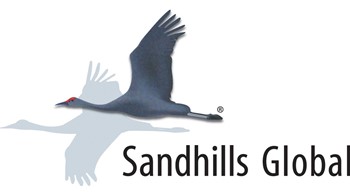
“The decrease in inventory levels for used turboprop aircraft, piston singles, and jets breaks a pattern of consecutive increases,” says Controller Department Manager Brant Washburn. “This underscores the adaptability of these markets. We're also seeing resilience, especially in piston singles, with asking values higher than last year and trending up.”
Sandhills’ aviation products include Controller, Controller EMEA, Executive Controller, Charter Hub, Aviation Trader, Aircraft Cost Calculator, and AircraftEvaluator. AircraftEvaluator is Sandhills’ proprietary asset valuation tool for all types of aircraft, built using the same technology behind FleetEvaluator. Widely used and trusted across equipment, truck, and trailer industries, FleetEvaluator identifies asset values with unparalleled accuracy.
The key metric used in all of Sandhills’ market reports is the Sandhills Equipment Value Index (EVI). Buyers and sellers can use the information in the Sandhills EVI to monitor equipment markets and maximize returns on acquisition, liquidation, and related business decisions. The Sandhills EVI data include equipment available in auction and retail markets, as well as model year equipment actively in use.
This report includes detailed analysis of asking values and inventory trends in used aircraft markets along with charts that help readers visualize the data. It describes and quantifies important trends in the buying and selling of used jet, piston single, turboprop, and Robinson piston helicopter aircraft.
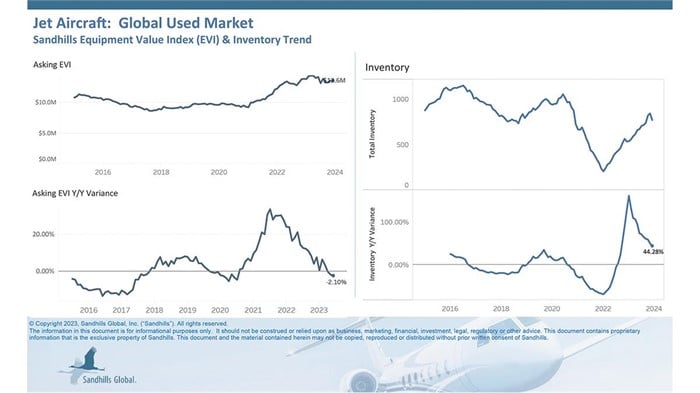
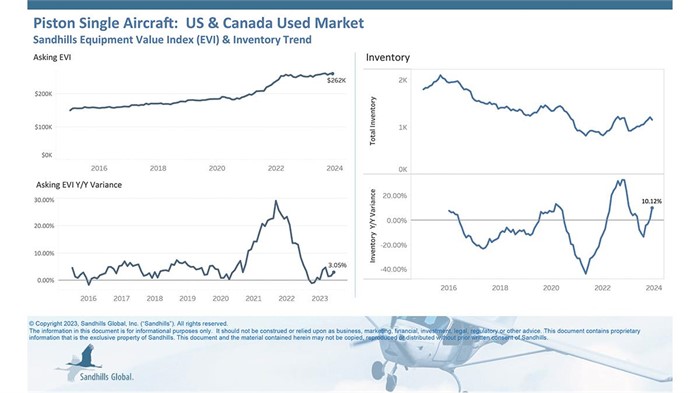
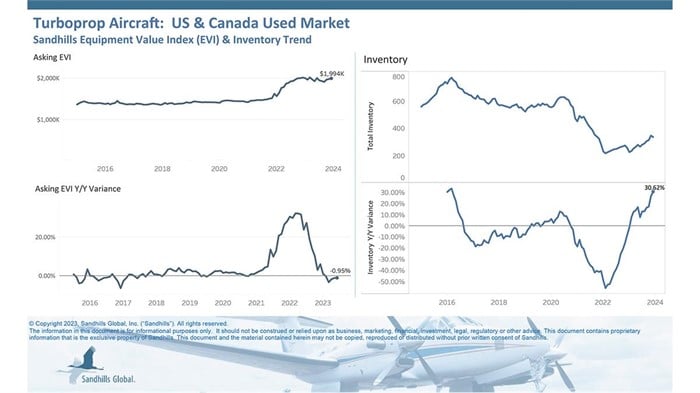
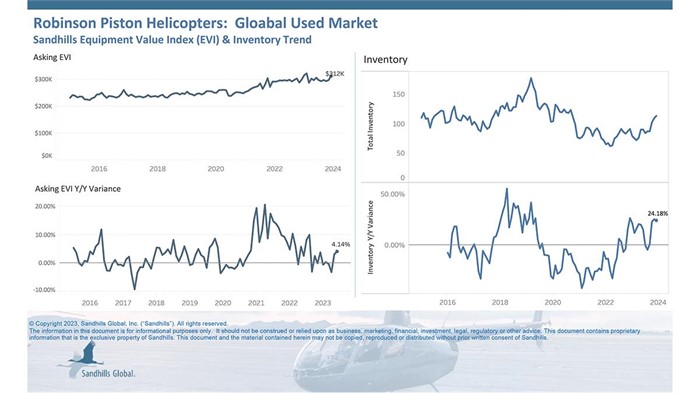
For more information, or to receive detailed analysis from Sandhills Global, contact us at [email protected].
Sandhills Global is an information processing company headquartered in Lincoln, Nebraska. Our products and services gather, process, and distribute information in the form of trade publications, websites, and online services that connect buyers and sellers across the aviation, construction, agriculture, and commercial trucking industries. Our integrated, industry-specific approach to hosted technologies and services offers solutions that help businesses large and small operate efficiently and grow securely, cost-effectively, and successfully. Sandhills Global—we are the cloud.
The Sandhills Equipment Value Index (EVI) is a principal gauge of the estimated market values of used assets—both currently and over time—across the construction, agricultural, commercial trucking, and aviation industries represented by Sandhills Global marketplaces, including Controller.com, AuctionTime.com, TractorHouse.com, MachineryTrader.com, TruckPaper.com, and other industry-specific equipment platforms. Powered by FleetEvaluator and AircraftEvaluator, Sandhills’ proprietary asset valuation tools, Sandhills EVI provides useful insights into the ever-changing supply-and-demand conditions for each industry.
www.sandhills.com/contact-us
402-479-2181

The EcoPulse hybrid-electric distributed propulsion aircraft demonstrator took its first flight on November 29, 2023, near Lourdes, France. (Image courtesy of Daher.)
Like so many industries, aviation is looking for ways to reduce carbon emissions and become increasingly sustainable. Engineers are working to lower fuel consumption and to find alternative fuels or power sources that don’t generate environmental pollution. To that end, Daher, Safran, and Airbus have been working together to develop a hybrid-electric aircraft concept, the EcoPulse, which recently took its first test flight.
The EcoPulse took its maiden flight in hybrid-electric mode taking off from Tarbes Airport near Lourdes, France, in late November. The Daher reports that the flight lasted around 100 minutes, during which the demonstrator put its e-Propellers (jointly powered by a battery and a turbogenerator) to the test. The flight also tested the craft’s flight control computer, high-voltage battery pack, distributed electric propulsion, and the hybrid-electric turbogenerator.
Prior to the hybrid flight, the EcoPulse had extensive ground tests and 10 hours of flight tests with the electrical system deactivated.
“We confirmed today that this disruptive propulsion system works in flight, which paves the way for more sustainable aviation,” says Safran Executive Vice President Strategy and Chief Technology Officer, Eric Dalbiès. “The lessons learned from upcoming flight tests will feed into our technology roadmap and strengthen our position as leader in future all-electric and hybrid-electric propulsive systems.”
First unveiled at the 2019 Paris Air Show, the EcoPulse has a disruptive propulsion system that allows a single independent electrical source to power multiple electric motors located throughout the aircraft. The goal of the project is to cut carbon emissions and reduce noise.
The EcoPulse is based on a Daher TBM platform and has six integrated electric thrusters (e-Propellers) along its wings. The propulsion system’s power sources are an electric generator driven by a gas turbine (turbogenerator) and a high-energy-density battery pack. A Power Distribution and Rectifier Unit protects the high-voltage network and distributes electrical power and high-voltage power harnesses. The aircraft’s battery pack is rated at 800 volts DC and supplies up to 350 kilowatts of power.
“This is a major milestone for our industry and we’re proud to have powered the EcoPulse demonstrator first flight with our new battery systems,” says Airbus Chief Technical Officer Sabine Klauke. “High-energy-density batteries will be necessary to reduce carbon emissions from aviation, whether for light aircraft, advanced air mobility, or large hybrid-electric aircraft. Projects like EcoPulse are key to accelerating progress in electric and hybrid-electric flight, and a cornerstone of our aim to decarbonise the aerospace industry as a whole.”
You’ll find a large selection of new and used aircraft from manufacturers such as Daher and Airbus for sale every day at AviationTrader.com.au.
To determine how much specific aircraft will cost your organisation over time, and to compare the operating costs of multiple types of aircraft, visit Aircraft Cost Calculator.
Source: Daher
If your dream is to adjoin regular flying trips in your own plane with tranquil lifestyle, Aquila Estate and Flying Club may be your perfect location. Aquila Estate is 15 minutes from Maryborough in Queensland, and under 35 minutes to Hervey Bay.
Here, you'll discover a manicured, 800 metre grass runway (05/23) with sealed taxiways to bespoke homes with your own hangar – all banked by forest with walking and cycling tracks.

When you're not out adventuring, you can relax and make use of the fully equipped impressive facilities. Enjoy the gym, pool, bar, in the fully-equipped clubhouse. There is a sense of community, family and relaxation throughout, an atmosphere unparalleled in Australia
Alternatively, if you want to perform mechanical works or you're thinking about building the dream kit plane, you can book one of two provided hangars with fully equipped workshops.
Offering a harmonious balance of natural and urban living and a lifestyle unlike any other, there are 62 blocks available from 2,400m2 to 4,000m2 and priced from $275,000.
Boeing Business Jets Introduces Premium Pre-Designed Cabin Interior Options For BBJ 737 Max 737-7 Executive Jet